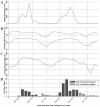Malaria hotspots drive hypoendemic transmission in the Chittagong Hill Districts of Bangladesh
- PMID: 23936345
- PMCID: PMC3735545
- DOI: 10.1371/journal.pone.0069713
Malaria hotspots drive hypoendemic transmission in the Chittagong Hill Districts of Bangladesh
Abstract
Background: Malaria is endemic in 13 of 64 districts of Bangladesh, representing a population at risk of about 27 million people. The highest rates of malaria in Bangladesh occur in the Chittagong Hill Districts, and Plasmodium falciparum (predominately chloroquine resistant) is the most prevalent species.
Methods: The objective of this research was to describe the epidemiology of symptomatic P. falciparum malaria in an area of Bangladesh following the introduction of a national malaria control program. We carried out surveillance for symptomatic malaria due to P. falciparum in two demographically defined unions of the Chittagong Hill Districts in Bangladesh, bordering western Myanmar, between October 2009 and May 2012. The association between sociodemographics and temporal and climate factors with symptomatic P. falciparum infection over two years of surveillance data was assessed. Risk factors for infection were determined using a multivariate regression model.
Results: 472 cases of symptomatic P. falciparum malaria cases were identified among 23,372 residents during the study period. Greater than 85% of cases occurred during the rainy season from May to October, and cases were highly clustered geographically within these two unions with more than 80% of infections occurring in areas that contain approximately one-third of the total population. Risk factors statistically associated with infection in a multivariate logistic regression model were living in the areas of high incidence, young age, and having an occupation including jhum cultivation and/or daily labor. Use of long lasting insecticide-treated bed nets was high (89.3%), but its use was not associated with decreased incidence of infection.
Conclusion: Here we show that P. falciparum malaria continues to be hypoendemic in the Chittagong Hill Districts of Bangladesh, is highly seasonal, and is much more common in certain geographically limited hot spots and among certain occupations.
Conflict of interest statement
Figures



References
-
- WHO (2011) World malaria report 2011. Geneva: World Health Organization.
-
- Murray CJ, Rosenfeld LC, Lim SS, Andrews KG, Foreman KJ, et al. (2012) Global malaria mortality between 1980 and 2010: a systematic analysis. Lancet 379: 413–431. - PubMed
-
- Singh N, Chand SK, Mishra AK, Bharti PK, Singh MP, et al. (2006) Epidemiology of malaria in an area of low transmission in central India. Am J Trop Med Hyg 75: 812–816. - PubMed
Publication types
MeSH terms
LinkOut - more resources
Full Text Sources
Other Literature Sources

